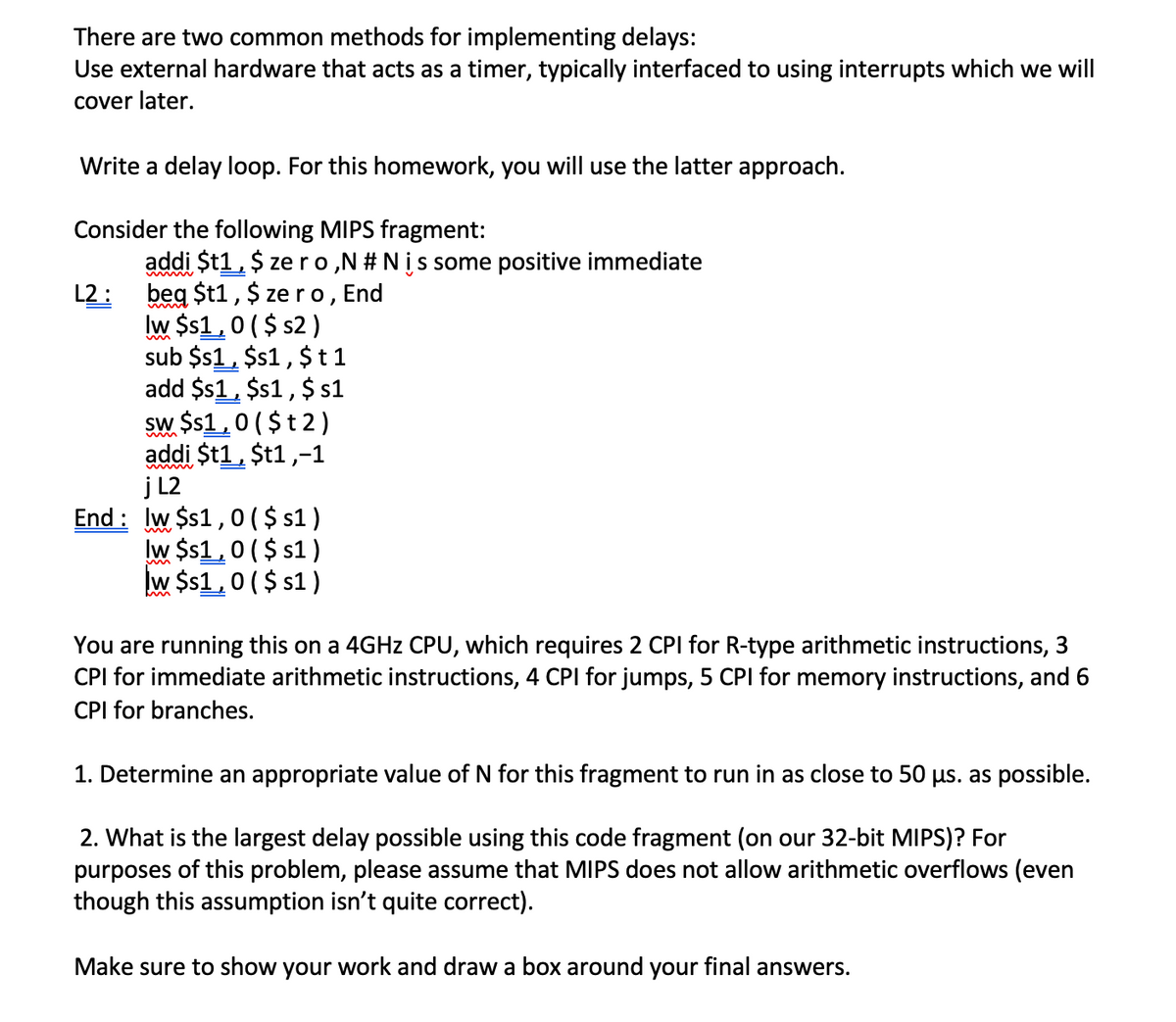There are two common methods for implementing delays: Use external hardware that acts as a timer, typically interfaced to using interrupts which we will cover later. Write a delay loop. For this homework, you will use the latter approach. Consider the following MIPS fragment: L2: addi $t1,$ zero,N #Nis some positive immediate beg $t1, $ zero, End lw $s1,0 ($s2) sub $s1, $s1,$t1 add $s1, $s1, $ s1 sw $s1,0 ($t2) addi $t1,$t1,-1 jL2 End: lw $s1,0 ($ s1) lw $s1,0 ($ s1) w $s1,0 ($s1) You are running this on a 4GHz CPU, which requires 2 CPI for R-type arithmetic instructions, 3 CPI for immediate arithmetic instructions, 4 CPI for jumps, 5 CPI for memory instructions, and 6 CPI for branches. 1. Determine an appropriate value of N for this fragment to run in as close to 50 μs. as possible. 2. What is the largest delay possible using this code fragment (on our 32-bit MIPS)? For purposes of this problem, please assume that MIPS does not allow arithmetic overflows (even though this assumption isn't quite correct). Make sure to show your work and draw a box around your final answers.
There are two common methods for implementing delays: Use external hardware that acts as a timer, typically interfaced to using interrupts which we will cover later. Write a delay loop. For this homework, you will use the latter approach. Consider the following MIPS fragment: L2: addi $t1,$ zero,N #Nis some positive immediate beg $t1, $ zero, End lw $s1,0 ($s2) sub $s1, $s1,$t1 add $s1, $s1, $ s1 sw $s1,0 ($t2) addi $t1,$t1,-1 jL2 End: lw $s1,0 ($ s1) lw $s1,0 ($ s1) w $s1,0 ($s1) You are running this on a 4GHz CPU, which requires 2 CPI for R-type arithmetic instructions, 3 CPI for immediate arithmetic instructions, 4 CPI for jumps, 5 CPI for memory instructions, and 6 CPI for branches. 1. Determine an appropriate value of N for this fragment to run in as close to 50 μs. as possible. 2. What is the largest delay possible using this code fragment (on our 32-bit MIPS)? For purposes of this problem, please assume that MIPS does not allow arithmetic overflows (even though this assumption isn't quite correct). Make sure to show your work and draw a box around your final answers.
Computer Networking: A Top-Down Approach (7th Edition)
7th Edition
ISBN:9780133594140
Author:James Kurose, Keith Ross
Publisher:James Kurose, Keith Ross
Chapter1: Computer Networks And The Internet
Section: Chapter Questions
Problem R1RQ: What is the difference between a host and an end system? List several different types of end...
Related questions
Question

Transcribed Image Text:There are two common methods for implementing delays:
Use external hardware that acts as a timer, typically interfaced to using interrupts which we will
cover later.
Write a delay loop. For this homework, you will use the latter approach.
Consider the following MIPS fragment:
addi $t1,$ zero,N #Nis some positive immediate
beg $t1, $ zero, End
lw $s1,0 ($s2)
sub $s1, $s1, $t1
add $s1, $s1, $ s1
sw $s1,0 ($t 2)
addi $t1,$t1,-1
jL2
End lw $s1,0 ( $ s1)
lw $s1,0 ($ s1)
w $s1,0 ($s1)
L2:
You are running this on a 4GHz CPU, which requires 2 CPI for R-type arithmetic instructions, 3
CPI for immediate arithmetic instructions, 4 CPI for jumps, 5 CPI for memory instructions, and 6
CPI for branches.
1. Determine an appropriate value of N for this fragment to run in as close to 50 µs. as possible.
2. What is the largest delay possible using this code fragment (on our 32-bit MIPS)? For
purposes of this problem, please assume that MIPS does not allow arithmetic overflows (even
though this assumption isn't quite correct).
Make sure to show your work and draw a box around your final answers.
Expert Solution
This question has been solved!
Explore an expertly crafted, step-by-step solution for a thorough understanding of key concepts.
This is a popular solution!
Trending now
This is a popular solution!
Step by step
Solved in 2 steps with 1 images

Recommended textbooks for you

Computer Networking: A Top-Down Approach (7th Edi…
Computer Engineering
ISBN:
9780133594140
Author:
James Kurose, Keith Ross
Publisher:
PEARSON

Computer Organization and Design MIPS Edition, Fi…
Computer Engineering
ISBN:
9780124077263
Author:
David A. Patterson, John L. Hennessy
Publisher:
Elsevier Science

Network+ Guide to Networks (MindTap Course List)
Computer Engineering
ISBN:
9781337569330
Author:
Jill West, Tamara Dean, Jean Andrews
Publisher:
Cengage Learning

Computer Networking: A Top-Down Approach (7th Edi…
Computer Engineering
ISBN:
9780133594140
Author:
James Kurose, Keith Ross
Publisher:
PEARSON

Computer Organization and Design MIPS Edition, Fi…
Computer Engineering
ISBN:
9780124077263
Author:
David A. Patterson, John L. Hennessy
Publisher:
Elsevier Science

Network+ Guide to Networks (MindTap Course List)
Computer Engineering
ISBN:
9781337569330
Author:
Jill West, Tamara Dean, Jean Andrews
Publisher:
Cengage Learning

Concepts of Database Management
Computer Engineering
ISBN:
9781337093422
Author:
Joy L. Starks, Philip J. Pratt, Mary Z. Last
Publisher:
Cengage Learning

Prelude to Programming
Computer Engineering
ISBN:
9780133750423
Author:
VENIT, Stewart
Publisher:
Pearson Education

Sc Business Data Communications and Networking, T…
Computer Engineering
ISBN:
9781119368830
Author:
FITZGERALD
Publisher:
WILEY